The world has definitely changed in the last year and a half. Some of us are back working in the office and some of us are still working from home. Some of us are working in small, dark second bedrooms, corner spaces, internal rooms, and more where, much like being at the office, we’re out of touch with nature. And by the end of the day, we’re too tired to go for a walk or tend to the garden – if we’re even lucky enough to have a garden space!
And while using a light therapy lamp can help make us feel better after a long day in the dark, it’s just not the same as being out in nature. Which is why we encourage everyone to fill that missing link with home office plants. Plants can help improve your mood, productivity and even satisfaction while on the job. They can also increase the humidity around your desk, remove toxins from the air, and add a touch of style to your desk.
A home office plant, especially one that is low maintenance, can thrive in low light and bounce back easily if they miss a water or too. They add colour and warmth to even the most boring office space. And choosing an easy to care for plant means you don’t add the stress of its survival to your already stressful workday.
So whether you’re lucky enough to have a sunny corner for your home office or a dark internal room, a great plant will thrive alongside you. From cacti to succulents, ZZ plants to pothos, the following list are the best plants for your home office space.
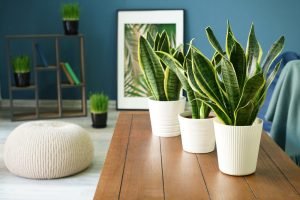
1: Snake Plant
The Snake Plant is our number one for a reason. Not only does it come in a number of stunning varieties, but it is one of the most tolerant home office plants you can get. Caring for a snake plant is very straightforward. You can neglect them for weeks and your snake plant will still bounce back after a good watering. They can survive in very low light, in drought, and have very few problems with insects. In fact, research by NASA shows that snake plants can keep your home clean by removing toxins, including benzene (a chemical used in, and given off by, plastics) and formaldehyde (a colourless gas used in a number of household products), from the air. Basically, they are the perfect home office plant.
Taking care of a snake plants is very easy. They need indirect sunlight. Don’t water them too much, especially during the winter. Allow the plant to dry out between waterings. You can give a little general purpose fertiliser for plants in a pot, and that’s it!
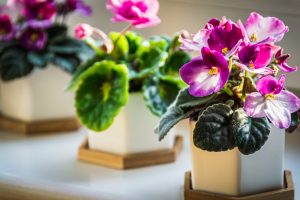
2: African Violet as Home Office Plants
While african violets might be intimidating to some people, these are utterly stunning plants. While they have a few quirks, these plants aren’t intimidating at all once you learn how to care for them properly. They are ideal to add to indoor space to add a cheerful and bright blooms to a dark, drab space. They take up very little indoor space. You can grow them in a small pot in groupings for a more showy display.
Potting should use speciality soil. Some stores will have it in stock or you might need to make your own from a mix of peat moss, vermiculite, and perlite in equal parts. Water needs to have stood for 48 hours and should be lukewarm when watering. Use a drop can so you don’t splash the foliage. Don’t let the plant fully dry out between watering. African violets need filtered light and it is good to turn the bot regularly. Fertilise with African violet fertiliser. Make sure you pinch out any dead flowers as this encourages even more flowers to grow!
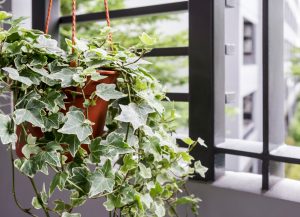
3: English Ivy
English Ivy is incredibly easy to care for and looks fantastic. You can plant it anywhere without worrying about maintenance. This ivy likes a shady area with organically rich soil. If the soil lacks organic matter, add some compost before planting. The vines grow very slowly, especially in the first year, so don’t worry if it seems like your plant isn’t making much progress at first. By the third year these plants will really take off and will need a trellis for it to climb and cover. When used as a home office plant, you can either place it in a hanging basket and let the vines casket down, or grow in a pot with a stake or trellis. There are a wide variety of species so you can choose the perfect look for you and your office space.
English ivy needs little care. Just water them often enough to keep the soil moist as the plants are establishing and growing. The vines grow best when they have plenty of moisture, but they also tolerate dry conditions once established. They hardly ever need fertiliser but if you don’t think your plant is growing as well as it should you can spray them with a half strength fertiliser.

4: ZZ Plant
ZZ Plants have wide, attractive green leaves and is perfect for home offices. They tolerate a great deal of neglect, is drought tolerant and can deal with low light conditions without sagging. It has beautiful waxy leaves that reflects light to brighten rooms. They grow slowly to a general height and width of 2-3 feet so it won’t outgrow your pots too quickly! And, like the Snake Plant, the ZZ plant NASA notes how adept it is at removing toxins from the air.
They are super simple to care for, making them perfect for preoccupied home office workers. They don’t need any special soils and only need a balanced liquid houseplant fertiliser once a month when watering. The ZZ plant is happy in low to bright indirect light. Water when fully dry. You can even miss a few waterings and the ZZ plant will still thrive. They are also resistant to diseases and insects.
The only drawback to the ZZ plant is that all parts of the plant are toxic. There were false rumours, in the early 2010s that the plant was so toxic that the plant was causing cancer. This plant is definitely not that toxic but should be kept away from pets and especially curious children.
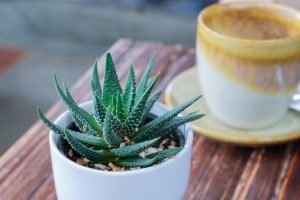
5: Aloe as Home Office Plants
For thousands of years people have been growing aloe vera plants. It is one of the most widely used medical plants in the world. They are easy to grow in the home, making them popular for home offices – and on Instagram. The first thing to remember is that aloe is the same as a succulent. They do best in dry conditions. It is best to plant aloe in a cactus potting mix or regular potting mix with additional perlite and/or building sand. You should also make sure your chose pot has plenty of drainage holes! Aloe vera plants cannot stand standing water.
Aloe plants do need bright light, so they do best if your home office is in a sunny corner. You should allow the soil to complete dry before watering your aloe vera plant again. When watering, completely drench the soil but ensure the soil drains freely. You don’t need to fertilise your aloe vera plant but if you want to, it should be done in spring with a phosphorous-heavy, water-based fertiliser at half strength.
And the helpful thing about aloe plants is that it can help treat minor burns and rashes! Not only is it the perfect plant for office spaces, but it can help you out in the long run, too!
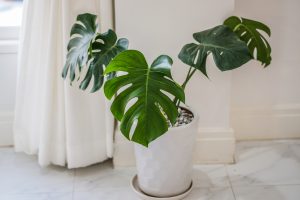
6: Philodendron
The philodendron is a mainstay for most inside gardens. They are easy to care for because, if you watch for the signals, the plant will tell you exactly what it needs. Even beginner plant owners will have no trouble growing these beautiful plants. Philodendrons readily adapt to conditions inside the home, making learning how to care for them extremely simple. They can thrive all years round without complaint but they do like the occasional stay outdoors in a shady spot. When you take the your philodendron outside, take the chance to flush the soil and clean the leaves of dust and grime.
Philodendrons need bright, indirect sunlight. Find a position near a window, where the sun’s rays won’t touch the foliage. It is normal for the older leaves to yellow, if several of the leaves yellow at once, the plant is getting too much sunlight. However, if the stems are long and leggy, with several inches between leaves, your plant isn’t getting enough light. When watering, allow the top inch of the soil to dry out between watering. Basically the length of your index finger to the first knuckle. Droopy leaves can also indicate the plant is either getting too much or too little water. But the plant will recover quickly once you correct your watering schedule.
You can feed a philodendron with a balanced liquid houseplant fertiliser specifically for foliage, that contains macronutrients. Water your plant with the fertiliser monthly through Spring and Summer, and around 6-8 weeks over Autumn and Winter.
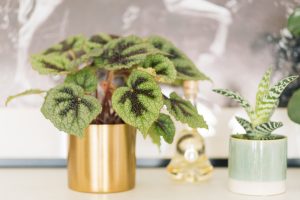
7: Rex Begonia
Rex Begonias are stunning, semi-tropical plants that make the perfect home office plants. They have been carefully cultivated as houseplants, which means you have a proven home office plants for your space. Rex begonias are known for their showy leaf colouration and large leaves that can measure up to 6 inches long. They are come in various shades of green, red, silver, and even purple. Just remember that rex begonias do go dormant in the winter.
The begonias like bright, indirect light, all year round. They don’t get a lot of flowers and can tolerate far less light than other begonia species and will even thrive under fluorescent light. They prefer an airy, fast-draining, light soil and regular watering. Just be careful to not over water them – ensure the surface of the soil is dry to the touch before watering. They love humidity but be careful misting the leaves. Don’t leave the leaves too wet as this encourages the growth of powdery mildew.
Ensure you give your begonia a weekly feeding of fertiliser at quarter strength or half strength every two weeks and you will have a happy plant.
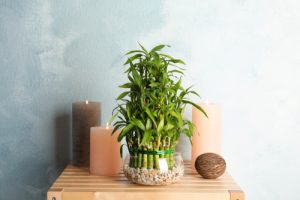
8: “Lucky” Bamboo as Home Office Plants
Lucky bamboo can be found for sale pretty much anywhere these days. They are a favourite for almost all office spaces, as well as home décor. They are called “lucky” bamboo as they are said to bring good luck and fortune to the people who own them, especially if they’re given as gifts. Three stalks, for example, are thought to bring health and happiness, while eight stalks are thought to represent development and prosperity. This hardy species of bamboo have a well-earned reputation as nearly indestructible. They can survive in vases of water to containers of soil, and in a wide variety of light conditions. Even the worst beginner plant owner can keep a lucky bamboo plant alive.
Despite their hardiness, there are certain growing conditions your bamboo needs to be healthy, including proper light, water, soil, and fertiliser. The lucky bamboo prefers bright, filtered sunlight. Avoid direct sunlight as it can scorch the leaves. This little bamboo is more tolerant of too little light than too much light. But if the plant begins to stretch or lose its green colour, provide some more light. Lucky bamboo prefers well drained, rich potting soil. The soil should be kept moist but not soaking wet. It can also thrive in a pebble soil or a vase of water, but it prefers soil.
Lucky bamboo is very sensitive to chlorine, however, as well as other chemical often found in tap water. Because of this, it’s a good idea to water you lucky bamboo only with bottled or distilled water. You can use tap water that has been left out for 24 hours to allow the chemicals to evaporate. A single drop of liquid fertiliser each month is plenty for your lucky bamboo.
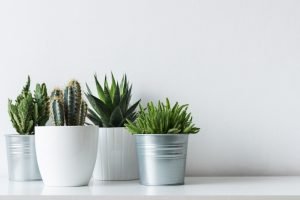
9: Cacti
Cacti, as well as succulents, are now one of the most common home office plants in the world. As a result, it is important that you know how to properly care for your cacti. Cacti come in a wide range of sizes, shapes and species, and can survive arid environments. After all, the native habitat for cacti is the desert. They grow best in lots of light, with good drainage, high temperatures, and low moisture. As a result, it is best to try and recreate their natural habitat. Cacti thrive in good light sources so it’s best to place your plant in a bright place if possible. However, be sure not to put them in direct sunlight as the intensity of the light can make the plants turn a yellowy colour.
Cacti like a free-draining compost or a speciality cactus soil that utilises sand and grit – the natural habitat of the cactus. There is a false rumour that cacti – and succulents – only need a small amount of water. While these plants have amazing water storing abilities, their leaves and stems allow you to survive in dry habitats but they won’t live without water. Overwatering will stunt growth but under watering will make your cactus shrivel. Tepid water is best for watering your cactus or cacti. In spring and summer water the plant at least once a week, allowing the soil to fully soak, while letting the excess water to drain away.
You can feed your cactus about once a month with a good cacti feed. Check with an expert, local nursery – like Aumanns – on the best feed to use for your cactus to encourage growth and flowering!
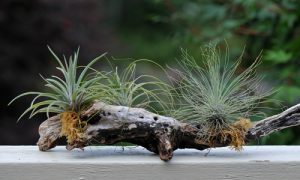
10: Air Plants
Air plants are strange and almost other worldly with the way they grow in just the air. They don’t require any soil and they have long, exotic leaves that some describe as looking like the appendage of an alien creature. Due to their fascinating appearance, and amazing styling options, air plants have become very popular in recent years. Just like cacti, succulents, and lucky bamboo, you can find them for sale almost anywhere. However, they are a little bit different to grow than regular home office plants.
Air plants are what we call epiphytes, which means they grow on other plants in nature, usually on tree branches. There are hundreds of species and varieties of air plants, making them exciting to own. Silver varieties tend to be more drought tolerant, while greener varieties dry out faster. Don’t ley the lack of soil scare you, these plants are easy to care for once you know what they need. They do still need a certain amount of water and light, just like other home office plants – you’ll know when an air plant is thriving when it begins to flower. Snip off any flowers once they dry out to ensure the air plant keeps growing and can bloom again.
These plants only have very small roots to allow them to hold onto whatever surface they are on. This means you should water one a week by placing them in a sink, deep enough to submerge the plants. Let them soak for about half and hour then turn the air plants upside down on a towel to let them dry. If you want, you can also mist your air plants between waterings, every other day, to keep them looking fresh – especially in winter. They need to stay out of direct light, preferring dappled shade or less intense morning sunlight.
These plants look great on their own or in groups. You can easily display a number of varieties together. They look great in terrariums or you can attach them to basically anything to create interesting displays. All you need is a bit of hot glue or translucent fishing line to secure them. Try creating a wreath, hanging mobile, or a gorgeous beach-themed terrarium. You don’t need to make much effort to create a fantastic air plant display.
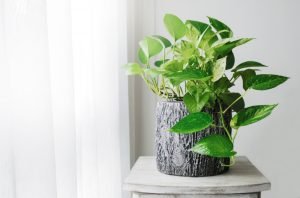
11: Pothos as Home Office Plants
Pothos plants are considered a great beginner home office plants. They are easy and undemanding, making them a great way to add greenery to your home office. Pothos enjoy a wide range of environments and do well in bright light as well as low light and can be grown in dry soil as well as vases of water. They love a nutrient rich soil as well as a nutrient poor soil making them perfect for even the worst gardener. Just don’t try to keep them in direct sunlight. If your pothos has lots of white on the leaves they may not grow well in low light as only the green part of the leaves will get enough light to make energy. So variegated – those with lots of white on their leaves – might not do well in low light.
Fertilise pothos once every three months to help the plant grow more quickly, but the plant will also grow quite happily without fertiliser, too. Let your pothos dry out only in the top 2 inches of soil before irrigating. If you let the plant dries out to the roots, the plant won’t grow. If you over water you can easily end up with root rot. Make sure when you water you let excess water drain out when you water.
While this is a fantastic, easy plant to take care of, they are poisonous. While not fatal, they will cause irritation and vomiting if eaten. It is considered toxic to cats, dogs and children, so keep out of reach of curious hands and mouths.
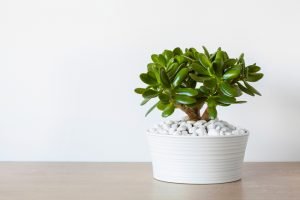
12: Jade Plants
Jade plants are super easy to care for and look fantastic in home offices and in your business office. They’re even considered symbols of luck! Jade plants do need to be watered properly. You should never let a jade plant dry out completely. Also do not water a jade plant too often, or you can cause root rot. The best way to water your jade plant is to water your plant is when the top soil is just dry to the touch. If you notice your jade plant is losing leaves or has spots on its leaves, then the plant isn’t getting enough water.
Jade plants need full sun in order to grow properly. If they don’t get enough sun, they get very straggly. They grow best in full sun at 18-24C. and for proper jade plant care you should fertilise your jade plant once every six months. You need to use a water soluble fertiliser. You need to fertilise after watering your plant normally – never fertilise your jade plant dry or it will damage the roots. And with this little TLC you can grow a beautiful jade plant to brighten your home office space!
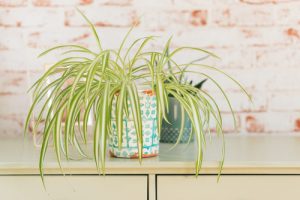
13: Spider Plants
If you are looking for one of the most adaptable home office plants, then you want a spider plant. This adorable plant can grow in a wide range of condition and suffers from only a few problems. It is called the spider plant due to it’s spider like growths (also known as spiderettes) which dangle down from the main mother plant like spiders on a web. They come in green and variegated varieties and will often have small white flowers.
Spider plants need well-drained soil and bright, indirect light, allowing them to flourish. Water them well but don’t allow the plants to become too soggy or they will get root rot. Allow the plant to dry out between waterings. Spider plants also like cooler temperatures, around 13-8C so find them a cool place indoors. They also like a good pruning, cutting them back to the base. While they like being in pots, so only repot when the large roots are highly visible and are making watering difficult. You can also plant any spiderettes you cut off to grow a new spider plant to give to friends and family.
Spider plants are incredibly hardy and thrive in less than optimal conditions. They prefer bright light, they tend to scorch in direct sunlight and prefer low light home offices. These plants prefer a well-draining, well-aerating potting medium. Water your plant throughout its growing season and mist occasionally as it loves humidity. Fertilising should be done in moderation and sparingly. Use an all-purpose, complete, water soluble or granular, time release fertiliser suitable for houseplants. Fertilise maybe once every 2 weeks and if the tips of the plant go brown, back off the fertiliser a little.
If you have cats, just be aware that cats are extremely attracted to spider plants. This is because spider plants are mildly hallucinogenic to cats, similar to catnip. While the plant is listed as non-toxic to cats, we recommend keeping it out of their reach to be on the safe side.
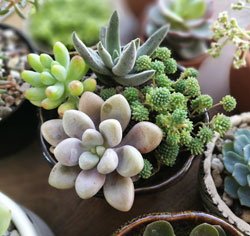
14: Succulents as Home Office Plants
Just like cacti, succulents have seen a boom in popularity in recent times. They are found in nearly every home and office, are low maintenance, and are available for sale nearly everywhere. And with their many, many varieties you can create a beautiful, unique green space around your home office with very little effort.
Succulents love light and need at least 6 hours of sun per day, depending on the variety of succulent you get. Newly planted succulents may scorch in direct sunlight so you may need to gradually introduce them into full sun exposure or set them behind a sheer curtain. You will also need to rotate you succulents regularly to prevent them from leaning toward the sun.
During Spring and Summer, you will find you need to water your succulent more often than Winter and Autumn. Allow the top 1.25 inches to dry out between waterings to ensure you aren’t over watering your succulents. The best way to water is to soak the soil until the water runs out of the drainage holes. Don’t use a mister or spray bottle as you want to avoid getting water on the leave as this can turn them mouldy. Instead, place the pot in some water, (only an inch or 2) and allow the water to absorb through the drainage holes. When the water at the top is moist, remove the pot from the water.
Keep your succulents clean, wiping dust off the leaves. Make sure you choose a pot with drainage holes, to allow the excess water to escape. Terracotta pots are ideal if you’re just beginning. Succulents need a good soil that drains, so you need either a specialised cactus soil or you need to mix a regular soil with sand, pumice and/or perlite. When repotting, be careful, as succulent roots are fragile.
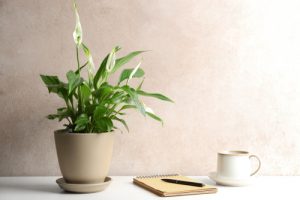
15: Peace Lily
A final popular choice for home offices, new apartment gifts, and everything in between, peace lilies are one of the easiest home office plants to care for. Peace lilies brighten up any living or home space, but are also excellent for cleaning your air from toxins. They have gorgeous dark green leaves and stunning white flowers. However, their growing conditions are important. Peace lilies prefer medium to low light. Lilies in more light will produce more, brighter flowers, while plants in low light will grow more like a foliage plant.
Overwatering is one of the most common issues people have with peace lilies. They are far more tolerant of being underwatered than overwatering. Don’t water the peace lily on a schedule. Instead, check on your lily once a week to see if they need watering. Touch the top of the soil and if it’s dry, water the plant. If the soil is still damp, leave the lily alone.
Peace lilies also don’t need frequent fertilising. They only need to be fertilised 1 or 2 times a year. What is more important is ensuring the plant is repotted when the outgrow their containers. If your plant is drooping less than a week after being watered and/or the leaves are being crowded and have deformed growth. You should move the plant into a pot that is at least 2 inches bigger than its current pot.
The wide leaves of the peace lily are an absolute dust magnet, so you need to wash and wipe them down. Dust prevents the leaves getting enough sunlight, which can prevent growth. Just wipe them down with a damp cloth. Or you can pop it in the shower and give the plant a very, very light shower!
Looking for your perfect home office plant companion? Come into your local Aumann’s Garden Supplies today. Our amazing team can help you find the perfect plant to suit your space and experience needs!

